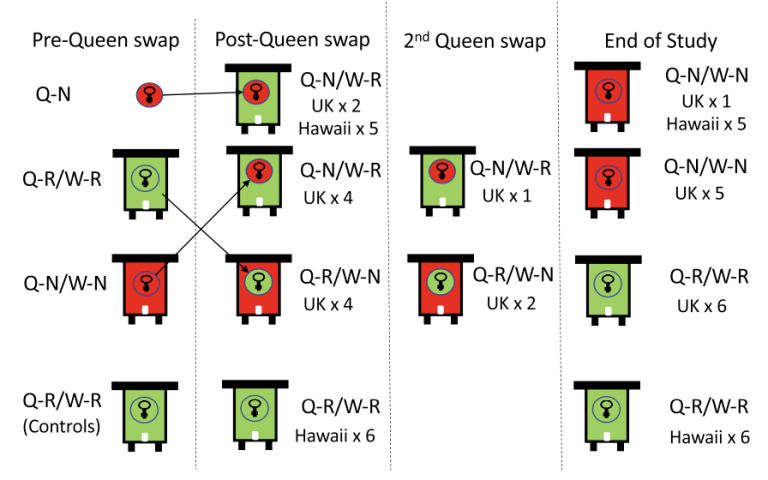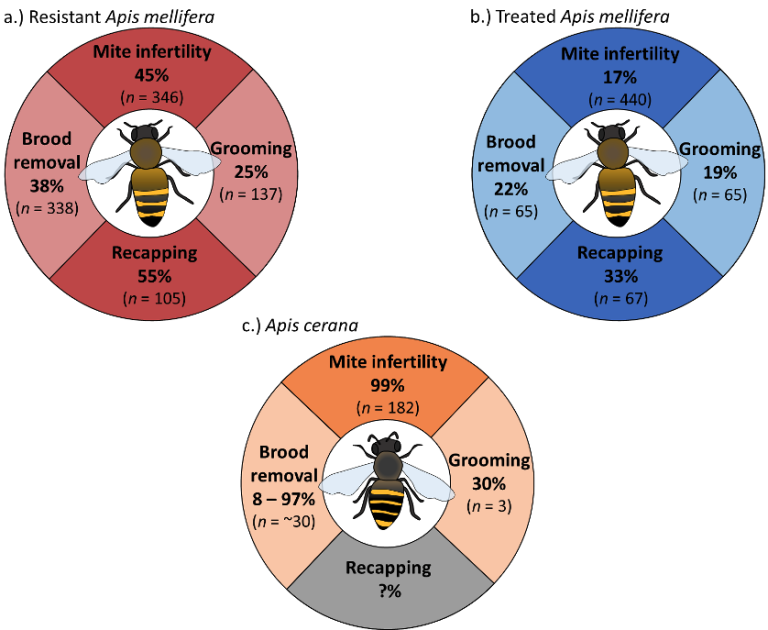The Scientific Evidence
To become a keeper of resistant bees you only need bees and knowledge
Rigorous scientific evidence is always required before an informed decision can be reached and advice given. This page provides a summary of each key study in chronological order that can be obtained for FREE by clicking the link. This page will continue to be updated with the latest key studies at the bottom so remember to scroll down.

Dr. I. Grindrod studying recapping in Cuba

Varroa treatment-free colony losses in the European honey bee (Apis mellifera): a review of published literature
By Gary Brook
Gary has conducted a review of colony losses assoicated with treatment-free beekeeping. He found that once treatment free colonies were established they could survive 20 years of more and winter colony losses of 6-17% were similar to control (treated colonies) at 8-23%.
Resistance to Varroa destructor is a trait mainly transmitted by the queen and not via worker learning . Martin et al 2024
How beekeepers can propagate the Varroa-resistant traits they have in their colonies depends on how varroa resistance, i.e. the key hygienic behavioural traits, are passed onto the next generation. Queen swap experiments conducted both in the UK and Hawaii both showed that to propagate mite-resistant traits, beekeepers only need to re-queen a colony with a locally mated queen from an established resistant population.


Rapid parallel evolution overcomes global honey bee parasite. Oddie et al. 2018
This was the first paper to make the link between increased recapping rates in resistant colonies. This ability was found in all four resistant populations (Norway, Sweden, and 2 in France). This was a major breakthrough that started me and others in measuring recapping levels in both resistant and treated colonies.
Varroa destructor reproduction and cell re-capping in mite-resistant Apis mellifera populations. Martin et al 2019
This was the first independent study to support Oddie's orignal 2018 findings i.e. resistant honeybee populations have high levels of recapping and the bees target the rarer infested brood. We studied resistant populations in Brazil and South Africa (2 distinct races) and found high recapping rates. We also showed than in honeybee colonies that had never been infested with Varroa recapping levels were very low.


Spatial distribution of recapping behaviour indicates clustering around Varroa infested cells. Grindrod & Martin 2021
This study solved the problem why so many non-infested cells are recapped, particular in resistant populations. We found that recapping occurred in clusters based around infested cells. We think the reason is due to the difficulty of locating which cells are infested so the bee opens up nearby cell caps.
Elevated recapping behaviour and reduced Varroa destructor reproduction in natural Varroa resistant Apis mellifera honey bees from the UK. Hawkins & Martin 2021
This was the first study to confirm high recapping levels and increased infertility in the mites in 26 resistant colonies relative to 16 treated colonies in the UK. The resistant samples came from 6 different widely dispersed UK apiaries. This data was similar to that collected in several countries suggesting the same mechanism had evolved.


Deformed wing virus prevalence and load in honeybees in South Africa. Souza et al., 2021
This study found that well established Varroa resistant populations in Brazil and South Africa had significantly lower viral loads irrespective of strain [ DWV-A (red) and DWV-B (blue)] than found in the treated populations in the UK and USA. The fact that an infested pupae in resistant colonies (far right box) still had the highest viral load suggests it is not that resistant bees have become resistant to the virus it just reflects the generally lower numbers of mites in resistant colonies.
Parallel evolution of Varroa resistance in honey bees: a common mechanism across continents? Grindrod & Martin 2021
This study combines the data from 60 previous studies to build a framework of the Varroa-resistance. Despite decades of work on Varroa-resistance this framework explains for the first time the mechanism of resistance and how the traits of increased recapping, increased brood removal and increased mite infertility are linked.


Recapping and mite removal behaviour in Cuba: home to the world’s largest population of Varroa resistant European honeybees. Luis et al 2022
Cuba is a little known country and currently has 221,000 European honeybee colonies that are resistant to Varroa. When Varroa arrived into Cuba in 1996 it was decided not to use chemical treatments and allow the bees to develop resistance naturally. This took several years to happen and initially colonies were lost. Once resistance became widespread colony numbers have steadily increased. Cuba is home to the world's largest population of European honeybees resistant to Varroa. We discovered high recapping, high mite removal and high mite infertility in the Cuba colonies supporting the framework we constructed.
A survey of UK beekeepers' Varroa treatment habits Valentine & Martin 2023
This survey asked 2,872 UK beekeepers about their treatment habits during winter of 2020/21. This found 72-79% of them were treated typically twice-yearly using chemical based methods. Also 6% had been treatment free for at least 6 years. That is the equivalent to 1,800 beekeepers managing resistant colonies throughout the UK. Although most appear to be based in England and Wales. Using this survey allows any shift towards managing resistant bees to be measured using this baseline survey.


Varroa resistance in Apis cerana: a review Grindrod & Martin 2023.
This is a review of Varroa resistance in A. cerana and reveals that much of what is known is based on small sample size, flawed experiments and repeating information that is not supported by scientific evidence. This is important when discussing Varroa resistance in Apis mellifera.
Chemical detection triggers honey bee defense against a destructive parasitic threat. (Mondet et al., 2021)
This is a comprehensive study of the compounds that trigger a behavioral defense associated with social immunity. Six Varroa-parasitization-specific compounds are identified, these consist of four ketones and two acetates that trigger hygiene behaviour towards Varroa infested cells. This enables the selective recognition of a parasitized brood and induce responses that result in the opening and removal of the infested pupae. They also show that individuals engaged in hygiene behaviour towards infested exhibit a unique ability to discriminate these 6 compounds from healthy brood signals.
These findings enhance our understanding of a critical mechanism of host defense against parasites, and have the potential to apply the integration of pest management in the beekeeping sector.


Pupal cannibalism by worker honey bees contributes to the spread of deformed wing virus (Posada‑Florez et 2021)
This paper studies the affect that DWV infection has on the colony when Varroa infested pupa are removed by cannibalism. It shows nicely that it opens up a new more natural transmission route of DWV among adult bees. However, the effects of DWV on adults are less than when you become infected as a pupae. It also may help explain why it takes several years for viral loads to reduce in resistant colonies as Souza et al. (2021) showed.
Geographical distribution and selection of European Honeybees Resiistant of Varroa. (Conte et al., 2020)
This is a major review by several of the European experts studying honey bee mite resistance. They discus known varroa-resistant populations in Europe. They also describe the results of surveys carried out mostly in Europe on the presence of naturally surviving honey bee populations. The authors found that there is a growing interest and awareness among beekeepers but that there are very few commercially available resistant lines. The most commonly considered traits for assessing varroa resistance are linked to mite reproduction and specific hygienic behavior of the bees.

